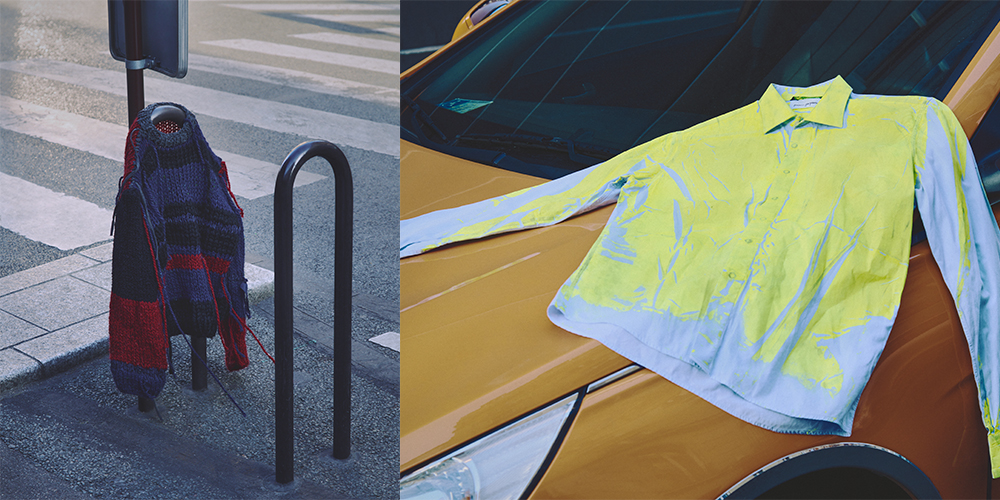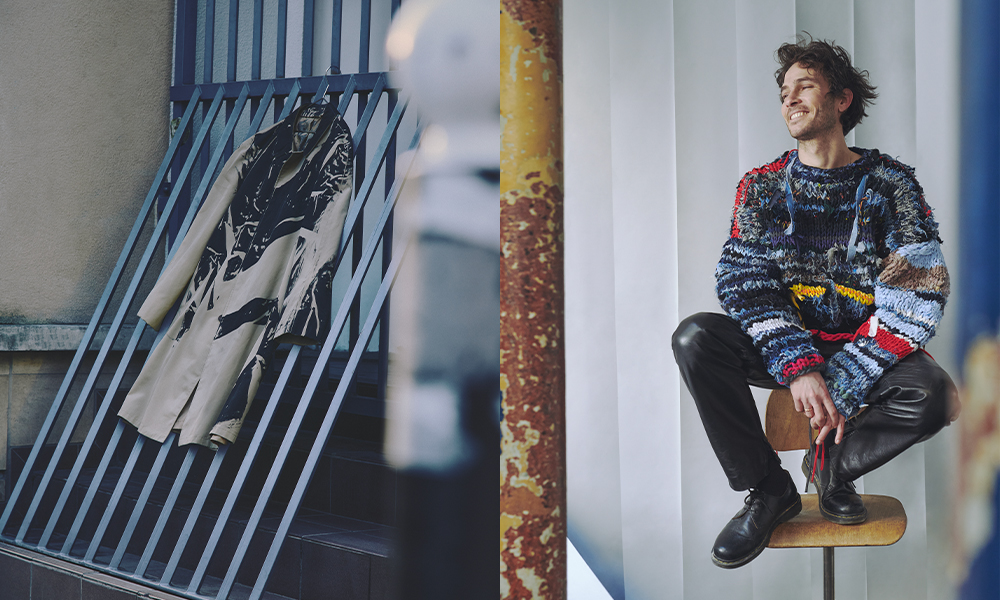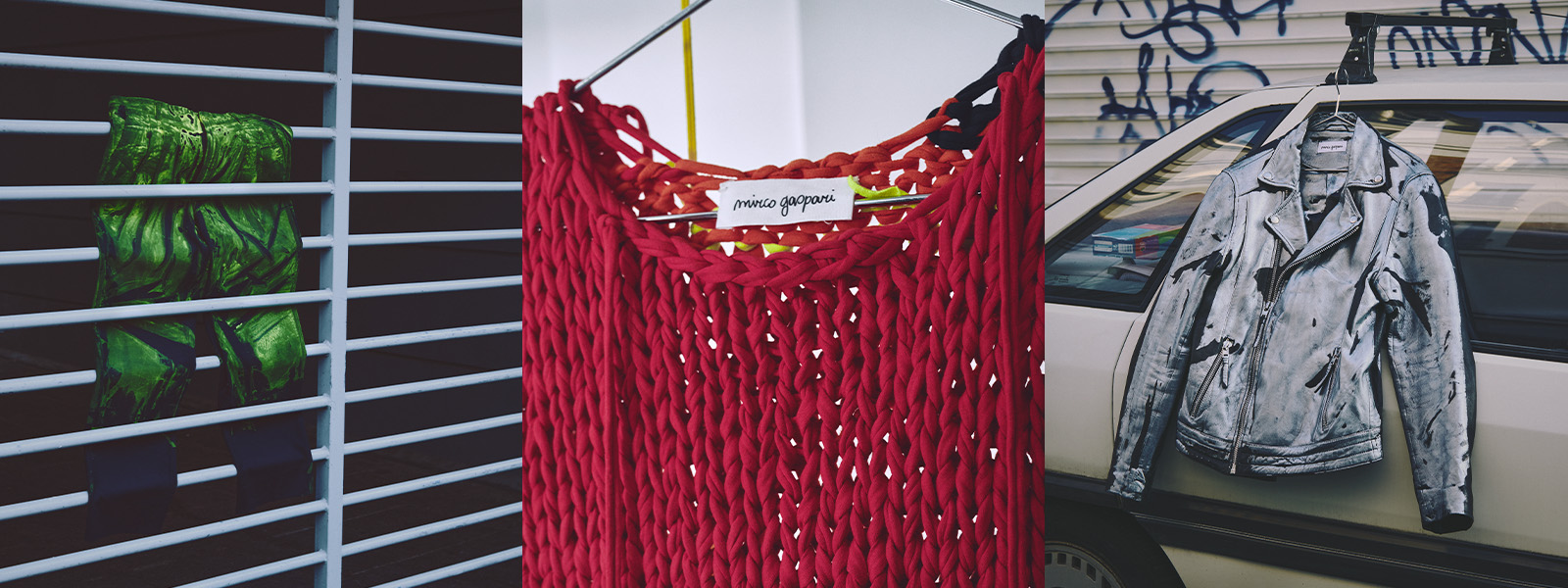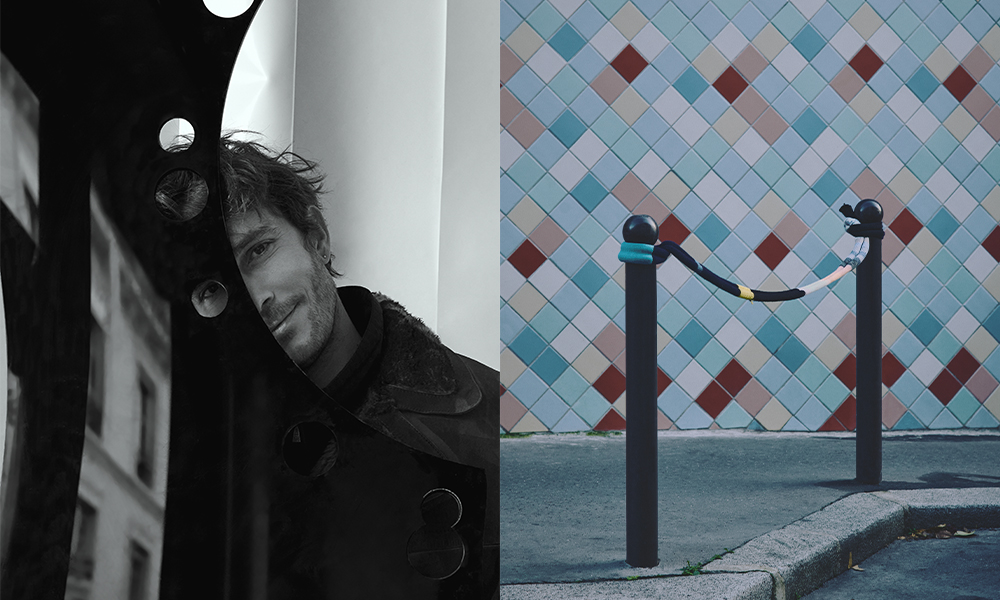
SUSTAINABLE SYMPOSIUM
MIRCO GASPARI
by Francesco Dossi
Mirco Gaspari lives the dream of almost every fashion design student. Born and raised in Italy, he moved to the historical established capital-symbol of the international fashion system: Paris. It’s here where he’s been able to fund and run his own clothing brand, relying on his creativity and limitless curiosity. Which is the only true guarantee of a never-ending personal and professional evolution. He’s a passionate advocate of a necessary change of those unsustainable practices fashion is accustomed to, his garments are an upcycled result of cut pieces of fabrics and dismissed clothes that’ve been recovered, re-imagined and renovated thanks to a multitude of different artisanal, sartorial and artistic techniques.
An Italian relocated in Paris, with a passion for fashion that your dressmaker mother passed on to you, as I’ve read. Can you tell us a bit about the path you followed to have your own brand? When was this goal of yours born?
I grew up at my mother Vania’s atelier: when I think of my childhood I can see the fabrics, hear the noises from the sewing machines, the irons stream, the smoky smell coming from the heat press. I remember very well the moment when I asked my mum to teach me how to sew, so that I could help her. All of it just to say that I’m passionate about this world since I was very little. After having studied art and fashion, I worked in advertisement and in wholesale and thanks to a friend of mine, I understood that if I wanted to have a personal brand, I should begin to create some garments and put into practice my ideas. Loving vintage since forever, one day I decided to buy a pair of jeans and to paint them as a gift for my friend; he wore them during a fashion week and was quickly noticed. After that, I started to receive numerous requests, the jeans got the attention of a buyer and finally a collaboration offer with Browns, in London, came.
Talking about sustainability, which are the main misunderstandings, preconceptions and wrong common beliefs, in your opinion?
I think about that belief for which people consider eco friendly is to keep buying thousands of garments for bargain prices on fashionable second-hand apps, when said garments will be worn only once and thrown away: it’s wrong. Because of this, with my job I always try to create special, high quality, eye-catching and customised pieces. A cool thing is that to this day some regular clients bring me clothes that they don’t want to wear anymore and together we decide the best way to breathe new life into them. My hope is that my clients aren’t going to separate from those renewed garments before 6 months, at least (and sometimes I’m certain of it).

Currently still so many people, fashion victims and not, find the second-hand offer unappealing. Do you think it’s a matter of a lack of personal sensitivity to the ethical-environmental issues or, more generally, of inadequate education about them? And if we compare the Italian and French scenarios, have you experienced any kind of differences in this regard?
I think, sadly, the problem could be a mix of insufficient education on the theme and the still spreading misinformation. I’m very hopeful towards the new generation though, because it seems to me that they are more interested in sustainable, eco- friendly matter, as much in general as in fashion. But to be honest, when I say that I’ve been wearing (for more than 10 years now) and working with only vintage and second-hand clothes, still many people don’t believe me, because they think it’s just not possible. Of course, I’m also aware of the fact that living in a big city like Paris (or like Milan) makes it easier and more accessible to purchase vintage and second-hand items, because of the larger selection and therefore the wider choice. I believe that’s actually what makes the biggest difference: the bigger, or smaller city scenarios, rather than the Italian, or French ones.
If I’m not wrong, you share La Boutique at the 10th arrondissement, in which you work and showcase your clothes, with a jewellery-related brand. Does this collaborative spirit mark your brand too? Do you work with a team or do you take care of your business on your own?
I’d love to collaborate with other brands and artists to work on team, or better than that, to have an actual team to manage the business! But I work alone at the moment, so I take care of everything all by myself: from the conceiving to the creation and the sale in my shop/atelier, which I share with a brand named Mimilamour.
On your website I read that your brand is characterised by an organic vision, which avoids any idea of seasonality, collection and mass production whatsoever. When creating new garments, do you begin with a previous and always changing inspiration or the garments themselves suggest you the most suitable way to revive them?
Most of the time it begins with a previous inspiration, so I look for clothes which I can work with, but sometimes it’s the contrary, therefore a garment suggests me how to act. For example, screen printing is my most used technique these days and I’m constantly researching garments that could get a plus effect from it; whereas the knitwear idea based on vintage T-shirts and other mixed materials comes from when I noticed all the fabric leftovers I had in the atelier.

The attention to materiality and the exploration of some particular kinds of crafting are at the base of your work of resurrecting discarded garments. Do you enjoy experimenting in your life, or is it an attitude developed with an upcycling practice, therefore restricted to your work?
More than experimenting I’d say that I love learning and reinterpreting; I’m like that in my everyday life too. I’m always looking for something new to study, apprehend or investigate and once I found it, I dive headfirst into it. As I said before, I learned to sew with my mum when I was little, but with time I refined the technique attending classes and making professional experiences. I practiced painting and drawing during my study years; I learned screen printing with an expert friend in Paris. I began to knit by myself (crochet and macramé too), to use a knitwear- specific vintage sewing machine and recently I enrolled in a design class. I’m also passionate about architecture, literature (Russian literature right now), history, cinema and photography.
What do you think is the main problem that the fashion industry has to face today, on the matter of sustainability?
Surely the overproduction issue. The eternal need to offer something new for 4 or more fashion seasons per year, every year, leads to the production of huge collections, that’ll eventually cause an overstock of shops and retailers (despite the 50% of the pieces manufactured for the runaway shows will be cancelled and not produced at all). As a result, they need to get rid of the garments with exaggerated discounts or, in the case of the biggest fashion brands, destroy them, in order to be prepared for the upcoming new season. All of it by exploiting people and resources that should’ve been respected and saved. Linked to it, I think it’s important to also speak about the pressure that people working in the supply chain of fashion are under every day, having to make sure to keep the newness cycles on going, from the designing part to the final sale one.
Is there a specific message that you would like to convey with your work? Is it something you do for yourself, meaning that it’s a profession you love and that makes you happy, or are you driven by a wish of being part of something bigger?
It’s something that begins with a personal need, that I do because I love to, that makes me feel good and that I wish could transmit a message of uniqueness and creativity; the idea that a garment was made for you and only for you and there will never be a similar one out there. At the same time, in my small way, I’d like to be part of something bigger: make people understand that it’s is possible to buy clothes in a more responsible way.Which my customers do, but also like all the artists, actors, and singers with whom I’ve the pleasure of collaborating and like all the people that purchase my clothes once they discover my work, which mostly happens on Instagram these days.

Credits: Pictures by Mathilde Hiley, Interview by Francesco Dossi